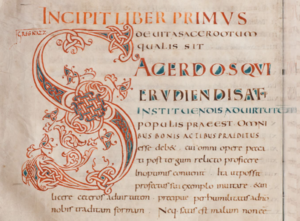Stuttgart, WLB, HB.VII.62: Difference between revisions
mNo edit summary |
m Text replacement - "Category:Manuscript digitized" to "Category:Digitized Manuscript" |
||
| Line 67: | Line 67: | ||
*Manuscript [[Category:Manuscript]] | *Manuscript [[Category:Manuscript]] | ||
*digitized [[Category:Manuscript | *digitized [[Category:Digitized Manuscript]] | ||
*saec IX [[Category:Manuscript saec IX]] | *saec IX [[Category:Manuscript saec IX]] | ||
*from Reichenau [[Category:Manuscript from Reichenau]] | *from Reichenau [[Category:Manuscript from Reichenau]] | ||
{{DEFAULTSORT:Stuttgart, WLB, HB.VII.62}} | {{DEFAULTSORT:Stuttgart, WLB, HB.VII.62}} | ||
Revision as of 22:20, 13 September 2024
| Library | Württembergische Landesbibliothek |
|---|---|
| Shelfmark | HB.VII.62 |
| Century | saec. IX (Autenrieth), saec. IXmed-3/4 (Burkhart), saec. IXex (Bischoff, Kerff, Kéry) |
| Provenance | ? |
| General region of origin | Lake Constance |
| Collection | Quadripartitus |
| Author | Bruno Schalekamp |
Stuttgart, Württembergische Landesbibliothek, HB.VII.62 is a ninth-century (second half) manuscript of 177 folios in 1 col. and 21 lines (275-280 x 235-240 mm). Its codicological composition reads as follows: 23 quires, (IV - 1)7 + 5 x IV47 + III53 + 4 x IV85 + II89 + 11 x IV176, fol. 94 should be counted twice; a single quire signature in Roman numerals at I7, modern foliation in Arabic numerals. The manuscript was penned by three hands (A: fols. 1v-78v and 86r-89v; B: fols. 79r-85v; C: fols. 90r-176r) in Caroline minuscule (Burkhart). It was written at Lake Constance, probably in Reichenau, according to Kerff, Kéry, and Burkhart. We find its first attestation in the catalogue of the Dombibliothek of Konstanz in 1343 and was in possession of St. Martin’s Abbey, Weingarten, from at least 1630 onwards (top right corner of fol. 1r reads: monasterii weingartensis anno 1630). A Weingarten signature was included on the front cover (D35).
Contents
The rather large manuscript consists almost exclusively of the Collectio canonum Quadripartita (Quadripartitus), with a few patristic excerpts (Jerome and Isidore de Seville), prayers (St. Gregory of Nanzianus), and an unknown liturgical song. Concerning the collection, this is one of three manuscripts containing all four books of the canonical work. Furthermore, this codex is one of two oldest witnesses of the collection. While one may be fooled by its 'straightforward' compilation, the extremely clear, neat, and professionally-prepared parchment indicates this was a very expensive codex. The written text itself is rarely abbreviated, indicating the scribes deliberately planned, mapped, and ruled the room available to pen down the large canonical corpus. It was written in a clear minuscule, by trained and consistent hands over a short period of time. Large and illuminated capitals introduce each of the four books. It must be noted the parchment quality starts deteriorating from fol. 174 onward due to probable water damage.

A striking feature of this manuscript is the large and beautifully decorated illuminated capitals. While these are spread throughout the whole codex, a few nearly take up a whole folio side (see fols. 3v, 16r, and 41r). The rubrics themselves are also regularly coloured in blue and red ink, indicating the codex was an investment and probably used as showpiece.
| folios | texts |
|---|---|
| Front cover, with an early modern list of contents | |
| 1v-175r | Collectio canonum Quadripartita (Quadripartitus), books 1-4 |
| 1v-3r | Preface, including dedicatory letter and list of authorities |
| 3r-14r | Book 1, including list of titles |
| 14r-38v | Book 2, including preface and list of titles |
| 39r-106v | Book 3, including preface and list of titles |
| 106v-175r | Book 4, including prologue, list of titles, and epilogue |
| 175v | Two excerpts of works of Jerome and Isidore of Seville |
| 175v-176r | Prayer ascribed to St. Gregory of Nanzanius |
| 176r | Unknown short prayer in a later hand |
| 176v | Unknown liturgical song(s). |
| Back cover. The ink of the liturgical song(s) on the last folio side, or another text that was previously positioned on the inside directly opposite of this cover, seems to have been imprinted on the inside of this cover |
Literature
Autenrieth, Die Handschriften (1963), p. 219-220; Bischoff, Festländische Hss. III (2014), n. 6092; Burkhart, Die vorromanischen Handschriften (2016), p. 27-28, tav. 25-30, n. 7; Kerff, Quadripartitus (1982), p. 24-25; Kéry, Canonical Collections (1999), p. 168; Löffler, Romanische Zierbuchstaben (1927), p. 44-45; Merton, Die Buchmalerei in St. Gallen (1923), p. 20; Swarzenski, Reichenauer Malerei (1903), p. 408.
See also Michael Elliot's extensive work and draft editions of the Quadripartitus on his own website: http://individual.utoronto.ca/michaelelliot/.
Categories
- Manuscript
- digitized
- saec IX
- from Reichenau
